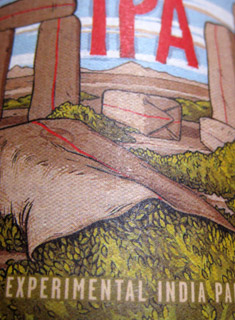 Both the beer and the details herein.
Both the beer and the details herein.
The press release Deschutes Brewery sent out for Hop Henge Experimental IPA describes the beer as “our annual exercise in IBU escalation, combining several new hop processes and techniques to create a unique and unexpected beer.”
Notice that although Hop Henge checks in at 8.75% and includes, according to the press release, 95 bitterness units that it is labeled neither Imperial nor Double. But it is one big ass beer, and were it entered as an IPA in a competition would surely be kicked for its big-assedness.
Deschutes first brewed Hop Henge in 2006, some years calling it an Imperial IPA, and jamming a boatload of hops into a beer is hardly new. So what’s this about experimental? I asked and lickety-split the answer arrived in an email from brewmaster Larry Sidor:
“As always, hopping is an adventure with Deschutes Brewery. We kicked off this year’s Hop Henge Experimental Ale by milling 1.0 pounds of Amarillo and Centennial hops per barrel in our grain mill. Yes, you read that right, the hops went directly to the mill along with the grain! So, we ended up with a green mash. Never fear, lautering went fine with a high performance German lauter tun.
“The next hop stop was at the Kettle. We added Millennium, Herkules (more German influence) and Northern Brewer at just at 0.99 pounds per barrel. The next wort hopping was in the hop back using Northern Brewer, Citra and Brewers Gold at 0.6 pounds per barrel.
“Drum roll please, the final wort hopping was with Cascade and Amarillo in the whirlpool at 0.8 pounds per barrel.
“Let’s see, we’re now up to 3.39 pounds per barrel just in the wort. We’re not stopping here.
“So, off to the fermenter where we added Centennial, Cascade and Amarillo at 1.32 pounds per barrel. These were hop pellets, very unDeschutes!) So next, we added 0.3 pounds per barrel of Citra in the bright beer tank. I can finally relax and get those damn pellets out of my tank and back to leaf hops! So after seven days on dry hops we called it good with a grand total of 5.01 pounds of hops added per barrel.”
Blame the power of persuasion but it seems you can smell a blend of citrus fruits — grapefruit, clementines — northwest pine trees, pineapples, and on and on through the cap. Really.
Besides they had me from the point when they milled the hops.
I want.
I’d sure like to know more about the effectiveness and efficiency of mash-hopping before I try it myself.
Brad – Several breweries in California have experimented with mash hops. They favor it in beers that do not have a massive hop bill, including some Belgian-influenced beers. They like it for the subtle hop flavors and mouthfeel.
I did love this tweet from @robbiexor: @Ab_eer @StanHieronymus Forget hopping during malting, let’s just crossbreed barley with Cascade
Stan, any indication how they calculate the IBU contribution from mash-hopping? And you’re saying it should be thought of as a flavor addition? Perhaps like first-wort hopping?
Brad – I don’t have a researched answer (I’ll see about fixing that) but intuitively that makes sense.
I wouldn’t think the IBU contributed would be included. How they got up to 95 measured IBUs is already crazy just because so much of it falls out of solution at those higher levels.
What I question is the difference between first wort hop additions and mash hopping. The only difference between the two is exposure time and sparging.
My other question is why such a subtle hop flavor would need to be present in an aggressively hopped beer. I know more is better, but I question the usefulness of the addition.
Dave – I don’t think this beer is about common sense. They brew it once a year, maybe they learn something.
Regardless…I think I have to agree with the writer…They had me at milling the hops.
I mean you can just tell they are trying something new and who doesn’t want to drink and experiment? I really want to know what this tasted like. It sounds like a crazy amount of hops to use and with as expensive as hops are how much would a beer like this cost were it mass produced or even produced on a local level?
Really interesting idea and you have to love America for its ability to toss out all rules and regulations and guidelines and try to make something its own.
Kudos
Mike
Mike’s Brew Review